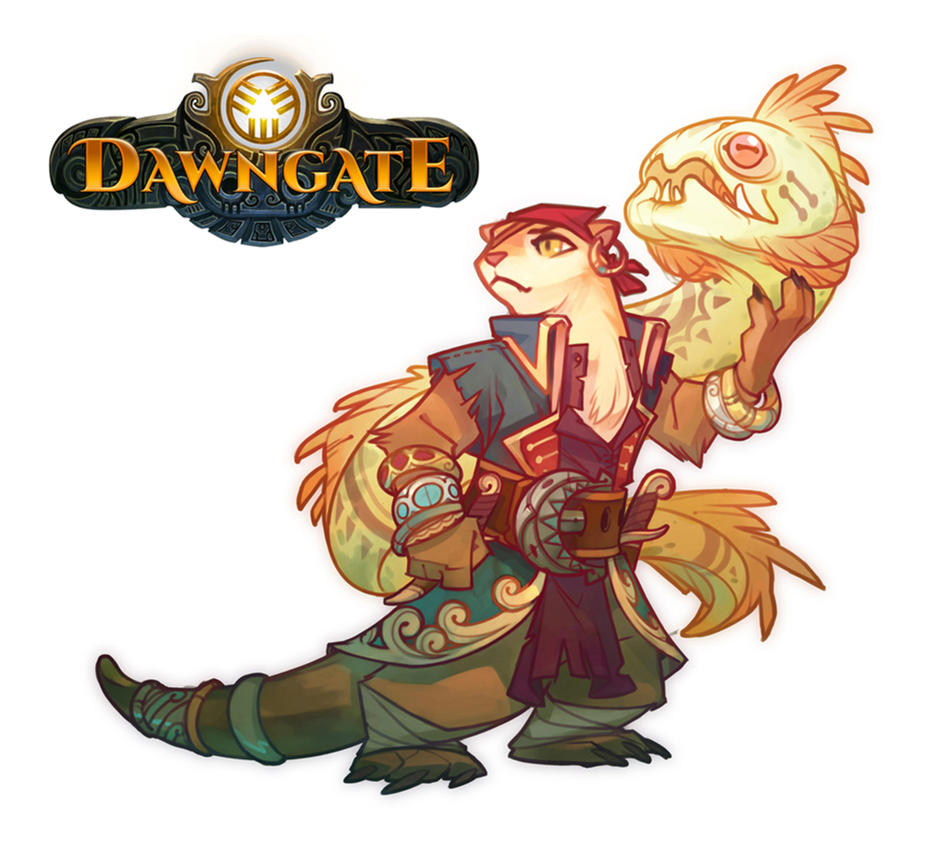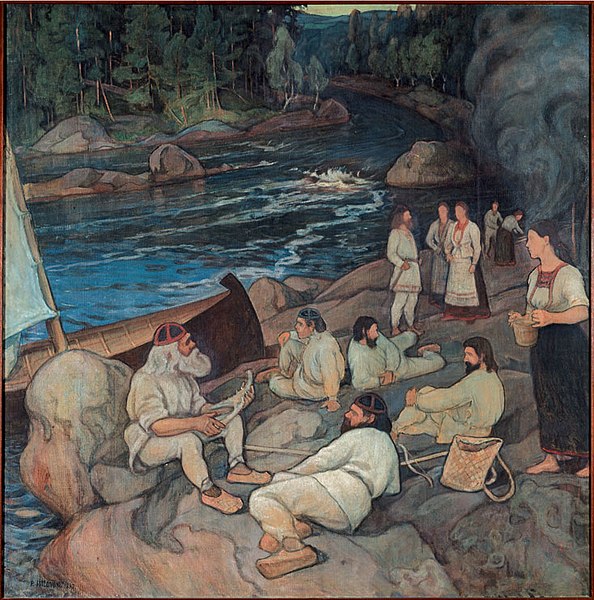The Orluk:
Mother Huldra bore one child. A child with brown fur and beady
black eyes. A long-necked child with dark whiskers. A strong jawed child. A
clever child. A child with sharp teeth and a short tail. A child who grew up
fast and was first of the Orluk. She is named Saumo and she is very old. Saumo’s
children tend to fields of flax and cultivated water reeds. They wear clothing of dried and woven reeds which don't get heavy in the water, a useful trait.They drape themselves in heavy woolen cloaks in the cold months. The well to do
wear fine fur hats and tightly fit linen vests, men and women both. The men have beards of thick, bristly whiskers.
Every useful
herb, every sweet-smelling fruit, every medicine root, and every use for river
reeds is known to them. They live everywhere. Most settlements in the lower and
middle river have Orluk enclaves but the largest Orluk communities are up the
river Altai where domes of wood with mud bases sit on the river bank. These
houses have an underwater entrance for escaping during wartime and for children
to swim in through. The Orluk travel the rivers in small
leather canoes or on the backs of Monster Toads, which they have domesticated.
The toads drag cargo in water proofed leather bags as they frog-kick down the
river. Orluk clans are large and closely woven, membership is passed down matrilineally. Some Orluks live like nomads on the river, only settling down for winter with the nearest cousin when its time for the toads to hibernate under the mud. There are secret handshakes and mundane rituals clan members use to identify themselves to their relatives on the other side of the river. Three clans control the trade in iron, extracted
from the bogs around the Altai, and have entered an uneasy alliance. They indulge
in Besharan spices and Voichean tapestries but live in fear of each other. Each
clan has separately decided to store their money in the belly of a fat swamp
troll who is muzzled, de-clawed, and heavily guarded. To get the coin out, a
troll-cutting knife is needed. The Orluk clan-mothers gather together
at the beginning of summer to honor Mother Huldra. They stand in the shallow
river and hold hands and cover themselves in water lilies. This ritual was
taught to the Orsuk by the Pike-Eye clan, but the Rowing People cannot
understand Mother Huldra, they only understand salt and rhythm and blood. Mother
Huldra is not the river Sargal. She is not the Altai. She is the whole
waterway, every stream and reservoir between the two seas. She is the spine of
the world. The Altai and western Sargal are her shoulder blades. All other
things are just extensions of her. Every summer she exhales and as she draws in
breath again winter begins. We are low before her.
 |
| Imagine this but with a more human face, hands, feet, and a greater hatred of eels (Artist) |
The Orluk consider the River Folk a delicacy, their flesh is
so greasy and muscular.
Guardian Sprits: Mother Huldra, Swift-Swimmer Saumo, The
Lily-Witch, The Frog God
Languages: Orluk, Trade Talk
Speed 25ft, Swim 20ft
-Can hold their breath for an hour
-Gain advantage on all nature checks relating to the Meager Country-Can hold their breath for an hour
-May move 5ft once a round as a free action without provoking opportunity attacks
Spirit Boon: Become immune to charm effects and life draining effects while wearing a crown of water lilies plucked at twilight. Once the blooms wilt, the effect ends.
 |
| You've sunk your last boat, pirate |
The River Folk:
They look like huge black eels with two spindly arms where their
fins should be. They have four fingers, their chests bulge uncomfortably when breathing air, and their striking yellow eyes are closer
together than an eel’s should be. They spawn in the sea and make their way up
the river Sargal as they grow. The farther up the river you go, the larger the
River Folk. They do not care for their young. They form small groups of equals called pits, short for eel
pits. Pits live in underwater burrows together and compete with other pits for
resources. Pits of stronger River Folk make the members of weaker pits fight
each other to the death for the right to join them.
The River Folk make short
trips inland to gather wood and other materials. Sometimes they build small
hovels of mud on the river’s edge to store supplies or for making smoked fish.
The River Folk dress themselves with jewelry made of clam shells and with crude
leather clothing usually made from horse hide. The River Folk are expert
scavengers, they scour ship wrecks for useful materials, like iron nails and sailcloth.
They also make shipwrecks. They attack boats at night, plunging hooks into
their sides and pulling oars into the water. Sometimes they’ll follow sinking
boats for miles. The older pits have learned how to make a flammable, sticky
substance called eel jelly. It burns when wet. There is nothing more terrifying
than a ring of fire appearing around your ship at midnight. The River Folk
believe they were the world’s first people before the land was raised and legged
creatures were born upon it.
 |
| Fear our slick sisters of the river |
Guardian Sprits: The Eel with 18 Coils, The Undertow
Goddess, Mother Huldra, the Fisher of Men
Languages: HIIIESH
Speed 20ft, Swim 45ft
-Darkvision
-Amphibious, can breath water and air for 12 hours at most
-Amphibious, can breath water and air for 12 hours at most
-Can move at full speed while crawling without being slowed by difficult terrain and without provoking opportunity attacks
-Slippery when wet, checks made to grapple River Folk are made at disadvantage and they gain advantage on saving throws against effects which would restrain them
Spirit Boon:
-Can eat a pearl wrapped in water weeds to start producing a thick mucus from their skin, which grants resistance to fire damage, +1 AC, and keeps the skin moist. This lasts for a day.
-Slippery when wet, checks made to grapple River Folk are made at disadvantage and they gain advantage on saving throws against effects which would restrain them
Spirit Boon:
-Can eat a pearl wrapped in water weeds to start producing a thick mucus from their skin, which grants resistance to fire damage, +1 AC, and keeps the skin moist. This lasts for a day.
 |
| UNHAND ME |
The Limber Folk
Like ghosts they stand, tall and thin, among the spindly
birches or the mighty pines. Everything about them is lanky and dry. Their hair
is like summer hay in texture and color, they all prefer to keep it loose
around their shoulders. When they are born, their skin is a light magenta,
sometimes tinged with blue. As they age, their flesh becomes darker and harder.
By 45, most have skin the color and thickness of tree bark and deep wrinkles.
This is considered extremely ugly and disgusting. A few get lighter as they
age, but their skin begins to thin and eventually peels off. Their thick,
brownish blood, drips down their peeling skin and becomes hard as amber. This
is considered very beautiful. The Limber Folk keep stout ponies, cattle with
thin horns, and big flightless birds with brown feathers and good singing
voices. Beyond this, and a great respect for mothers, the different groups of
Limber Folk share little.
Speed 30ft
-Ignore difficult terrain created by vegetation and shallow
water
-Treat half cover created by vegetation as three quarters
cover
- Limber People gain +1 AC as natural armor for every 10 years they age over 15
-Thick Blood, advantage on all constitution saving throws
-Thick Blood, advantage on all constitution saving throws
The Untamo:
The forests of the Untamo are dark and swampy. They build
halls with long sloping roofs and wooden shacks on the banks of mossy lakes and
among swampy stands of trees. They remember themselves as tall and mighty in an
age long forgotten before famine and disease were invented, the age of Heroes
and of Long Stanzas. They clear swampland to let their animals graze and grow
their few crops, wheat and barley, upon. Their most treasured animal is a sheep
with wool like silk. However, all the fabrics they wear are scratchy and dry, but
this doesn’t bother them. The Untamo are masters of woodwork. They weave shoes,
baskets, and backpacks out of birch bark and can build a boat without a nail.
They still know ironwork though and the richest among them wear twisting copper
jewelry. The Untamo are not well organized. Families live far apart in their
own halls and come together for festivals, weddings, trade, and war.
They have no kings or chiefs in the traditional sense. Authority is usually derived from age and experience, or from wealth in a pinch. Untamo shamans are called Singers. They remember the Long Stanzas, the record of the Untamo from the beginning of time and before it. By recalling the origin of a thing it can be controlled, if the right song is sung, the right magic words are used. The trees will bend to he who knows the story of how the world was made fertile. The wounds will close of she who knows how Oli Maki discovered iron. The greatest singers can make the spirits weep and sing flesh to wood, water to honey, and sand to grain. When a pair of twins is born, they are given to the nearest Singer to be instructed in the Stanzas. They will close their eyes, intertwine their hands, and recite the entire history of the Untamo in the darkness. Friend of Deep Waters came first and sung first, he planted seeds from which the Limber Folk sprung. He was born older than old. Oli Maki invented the forge and made the sky. The two had many adventures in that glorious age when starvation was unknown and men only made war for sport. The Blind Witch ended this age, jealous was she of the wonders of Oli Maki’s forge. The most sacred space of the Untamo are the Spirit-Trees, silvery birches which rise from the swamp floor. The most important festivals are held here. Each Spirit-Tree has, in the past, produced disks of Silver Chain and sheets of Sky Metal. Silver Chain armor is made by threading fiber or sinew through the perfectly square holes of each disk. Friend of Deep Waters left these for his people, the disks are etched with prayers for good fortune in his ancient language. Sky Metal is a dark purplish red color. It is incredibly hard yet flexible. This armor is treated with great reverence and only the most respected warriors may don it. Though the heroes of the past receive the most reverence, bear worship is becoming more common, and the abandoned spirits of the Hisvek are finding new worshipers among the Untamo.
 |
| Tell us how the world was born (Artist) |
They have no kings or chiefs in the traditional sense. Authority is usually derived from age and experience, or from wealth in a pinch. Untamo shamans are called Singers. They remember the Long Stanzas, the record of the Untamo from the beginning of time and before it. By recalling the origin of a thing it can be controlled, if the right song is sung, the right magic words are used. The trees will bend to he who knows the story of how the world was made fertile. The wounds will close of she who knows how Oli Maki discovered iron. The greatest singers can make the spirits weep and sing flesh to wood, water to honey, and sand to grain. When a pair of twins is born, they are given to the nearest Singer to be instructed in the Stanzas. They will close their eyes, intertwine their hands, and recite the entire history of the Untamo in the darkness. Friend of Deep Waters came first and sung first, he planted seeds from which the Limber Folk sprung. He was born older than old. Oli Maki invented the forge and made the sky. The two had many adventures in that glorious age when starvation was unknown and men only made war for sport. The Blind Witch ended this age, jealous was she of the wonders of Oli Maki’s forge. The most sacred space of the Untamo are the Spirit-Trees, silvery birches which rise from the swamp floor. The most important festivals are held here. Each Spirit-Tree has, in the past, produced disks of Silver Chain and sheets of Sky Metal. Silver Chain armor is made by threading fiber or sinew through the perfectly square holes of each disk. Friend of Deep Waters left these for his people, the disks are etched with prayers for good fortune in his ancient language. Sky Metal is a dark purplish red color. It is incredibly hard yet flexible. This armor is treated with great reverence and only the most respected warriors may don it. Though the heroes of the past receive the most reverence, bear worship is becoming more common, and the abandoned spirits of the Hisvek are finding new worshipers among the Untamo.
Guardian Spirits: Friend of Deep Waters, Oli Maki the
Primaeval Craftsman, Ahto the Sword-Singer, Uulou the Honey Eater, Rainbow
Maiden, Water Mother, Sky Father
Languages:
-Can be cured of all diseases and spiritual ailments (possessions, life drain, ect) by spending three days straight in a sauna without food or water
-Can be cured of all diseases and spiritual ailments (possessions, life drain, ect) by spending three days straight in a sauna without food or water
 |
| His songs are stronger (Artist) |
The Lapuans:
 |
| What an age it was (Artist) |
They are just barely people of the Meager Country, the
Untamo have been pushing them northward as far as memory goes. A few clans have
gone full bore and traveled far north as one can go. The Droven call them Reindeer
Riders and are terrified by them. The majority of the Lapuans can be found north
of the Altai or between the Uulung mountains. They are semi-nomadic. They build
foundations of stacked stones and bury supplies in pits, then circle round
between these camps the whole year round. Some tribes only have a summer and
winter camp, they raise honeybees and grow crops like the Untamo. Unlike their
arctic brothers, the Lapuans of the Meager Country just have their ponies to
ride on, though they’re starting to catch onto this reindeer thing. Lapuan
shamans are few and far between. They are outcasts rather than pillars of their
communities. They can control the forces of disease and lay mighty curses on
those who upset them. A word from the shaman’s mouth can be enough to shred
your being into its five constituent parts. The phrase “crawl back to your
mother’s womb” is greatly feared. The Lapuans maintain that it was The Blind Witch
of the North who made the Limber Folk out of tree sap and snow and that the
fault for ending the age of Long Stanzas (or the age before ages, as the
Lapuans call it), lies with Friend of Deep Waters for trying to steal Oli Maki’s
Engine after he could not have the hand of Rainbow Maiden in marriage. Maybe if
he could keep his lusts to himself, the Blind Witch would never have had to
give birth to the 9 Plagues.
Guardian Sprits: The Blind Witch of the North, Rainbow
Maiden, The Lone Shepard, The 9 Plagues, The Mischievous One
Languages: Limber Language
-Can easily call a spirit of the North Wind by burning a pine branch, a handful of snow, and a drop of blood. The spirit will swirl around the one who's blood was offered to it and give them resistance to cold damage. The spirit can be dismissed as bonus action. This creates a mighty gust of wind, all creatures within 25ft of the spirit's controller must make a DC 14 Dexterity saving throw or fall prone. Torches are snuffed out, water and food freezes. If not dismissed this way, the spirit will stay for half a day.
 |
| The Lair of the Lynx by Akseli Gallen-Kallela, 1906 |
New Items:
A Jar of Eel Jelly. A small clay pot with a cork inserted through the center. One half is jelly, the other is water. If the jar is successfully thrown at an enemy, they are covered with ignited eel jelly. At the start of their turn, they take 1d8 fire damage. They may use an action to attempt a DC 13 Dexterity saving throw to get the sticky jelly off.Silver Chain Armor. Heavy Armor, 17 AC, 13 STR, only takes up 6 inventory slots
Sky Metal Plate. Medium Armor, 18 AC, only takes up 4 inventory slots
Toad Whistle. Made of river reeds folded just so. Blow it and all frogs and toads within 120ft will be alerted and hop toward you. Blow it for longer than 10 seconds and all frogs and toads within 120ft will flee you.
This post is dedicated to Chris L'Etoile, who never responded to my email
No comments:
Post a Comment